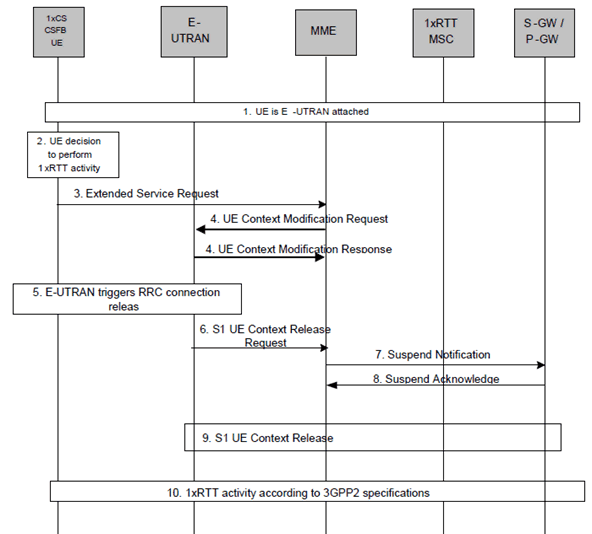Content for TS 23.272 Word version: 19.1.0
1…
4…
5…
5.4…
6…
6.3
6.4…
7…
7.3
7.4…
7.5a…
8…
8.2.4a…
8.3…
8.4…
B…
B.2…
B.2.2…
B.2.3a…
B.2.3a.4…
B.2.4…
B.3…
C…
C.8…
B.3 CS Fallback for UEs with dual Rx configuration
B.3.1 General Considerations
B.3.2 Procedures for leaving E-UTRAN
B.3.3 Procedures for returning to E-UTRAN
...
...
B.3 CS Fallback for UEs with dual Rx configuration |R9| p. 91
B.3.1 General Considerations p. 91
The following principles are used for supporting CS Fallback for dual receiver UEs:
- The UE with dual Rx configuration attaches separately to each RAT (E-UTRAN, 1xRTT) and maintains separate registration and mobility procedure handling to each RAT. No coordination is required between the E-UTRAN and 1xRTT network.
- The UE with dual Rx configuration is able to camp in 1xRTT at the same time as it is active or idle in E-UTRAN. Camping in 1xRTT includes performing 1xRTT cell re-selection, reading broadcast channels, monitoring paging, performing location updates, etc. according to 3GPP2 specifications.
- The UE with dual Rx configuration is allowed to leave E-UTRAN in order to handle a CS call and/or perform registration signalling, and/or sending or receiving SMS in 1xRTT. The procedures for leaving E-UTRAN is described in clause B.3.2 and are only allowed if the network indicates that it supports them (this is indicated by either the presence of CSFB registration parameters or indication of support for dual Rx CSFB on E-UTRAN broadcast channel, TS 36.331).
- The UE that reports dual Rx configuration to E-UTRAN does not require redirection information.
B.3.2 Procedures for leaving E-UTRAN p. 92
The UE with dual Rx configuration is allowed to leave E-UTRAN in order to handle a CS call and/or perform registration signalling, and/or perform location management signalling, and/or sending or receiving SMS in 1xRTT. When the UE needs to leave E-UTRAN it indicates this to E-UTRAN by using the Extended Service Request procedure similar to how MT/MO calls are handed in clause B.2.2, clause B.2.2a and clause B.2.3. The procedure is the same regardless what activity is performed in the 1xRTT system (e.g. if it is a page response, MO call, re-registration). The procedure is shown in Figure B.3.2-1.

Figure B.3.2-1: Performing 1xRTT related activity for dual receiver UEs
(⇒ copy of original 3GPP image)
(⇒ copy of original 3GPP image)
Step 1.
UE is E-UTRAN attached the UE may also be registered in 1xRTT CS.
Step 2.
UE makes a decision that it needs to perform some 1xRTT activity (e.g. in order to respond to an incoming 1xRTT page, setup a MO call, perform location management signalling, or perform re-registration).
Step 3.
UE sends an Extended Service Request for mobile originating/mobile terminating 1xCS fallback to the MME. The Figure shows the case the UE is in active state in E-UTRAN but the same principles applies if the UE is in idle state, TS 23.401.
Step 4.
MME sends UE Context modification Request (CS Fallback Indicator) to E-UTRAN. CS Fallback Indicator indicates to the E-UTRAN to move the UE to 1xRTT.
E-UTRAN responds with UE Context Modification Response.
Step 5.
The E-UTRAN triggers RRC connection release and continues with step 6. This step may include re-direction information if the E-UTRAN indicates support for S102. E-UTRAN that indicates support for dual Rx CSFB shall not include any redirection information towards the UE that indicates dual Rx configuration but no support for enhanced CS fallback to 1xRTT.
Step 6.
E-UTRAN sends an S1 UE Context Release Request (Cause) message to the MME. Cause indicates that the S1 UE Context Release was caused by CS fallback to 1xRTT.
Step 7.
The S1-U bearers are released and the MME starts the preservation and suspension of non-GBR bearers and the deactivation of GBR bearers towards S-GW and P-GW(s). by sending Suspend Notification to S-GW and P-GW The MME sets the UE context to suspended status.
Step 8.
The S-GW and P-GW(s) acknowledges the bearer updates by responding with Suspend Acknowledge and marks the UE as suspended in S-GW and P-GW. When a downlink data arrives at the P-GW, the P-GW should not send downlink data if the UE is marked as suspended.
Step 9.
S1 UE Context in the E-UTRAN is released as specified in TS 23.401.
B.3.3 Procedures for returning to E-UTRAN p. 93
The procedure for returning to E-UTRAN is the same as specified in clause 6.5.